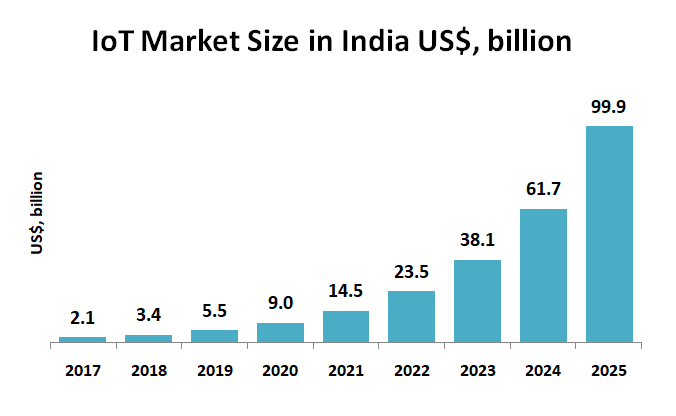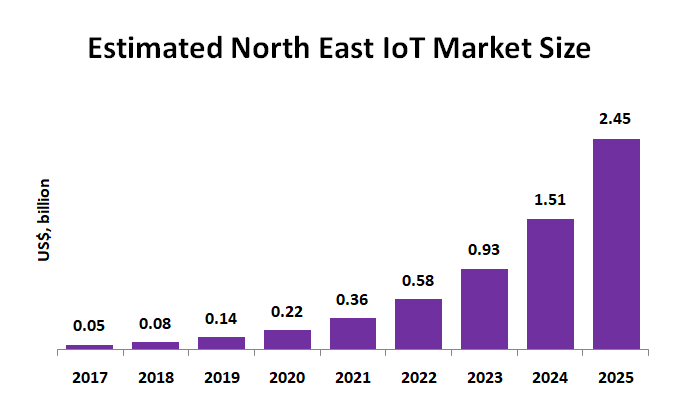How IoT technology can help agriculture positively?
With the expected $14 trillion global economic contributions by 2030, IoT is emerging as one of the topmost enablers of the digital transformation of the business world.

By Admin
What is IoT?
At present day, devices for sensing, actuation, processing, and communication advancement has technology enthusiast to build and transform “things” into a complex and dynamic system of connected things on an unprecedented scale.
So, IoT can be described as “things” which are connected via embedded sensors, software, and other technologies on them for the purpose of networking and exchanging data among themselves and on the network systems over the internet.
More advanced emerging technology products is helping the spread of IoT across a domain. One can read many articles every day on drones with a mission, drone photography, connected cars or driverless car, smart homes, electronic toys to monitor child health-safety, pill-shaped micro-cameras that can pinpoint thousands of images within the body to smart sensors that can assess crop conditions on a farm, etc.
“The global Internet of Things market size to be USD 110 billion in 2017 and is expected to reach USD 1,567 billion by 2025, at a Compound Annual Growth Rate (CAGR) of 39.38% during the forecast period.”
Future of IoT
Technological development, an adaptation of technology, reducing costing has to lead to large scale implementation of the Internet of Things (IoT) projects across geographic boundaries and sectors. In every local market business, consultants are getting numerous inquisitive questions on the application of the Internet of things (IoT) for their business growth in the local market. As a technology enthusiast one can see the vast application of IoT across Industries. North America is the biggest contributor to the application of IoT across industries. Some of the contributing factor high application of IoT in North America has established economies, governmental policies, investment in R&D, and a very strong startup ecosystem. With an ever-increasing network of tens of billions of internet-connected electronic devices that are already in operation around the world and as business analysts expected this number to grow steeply considering the fact that a great number of electronic devices are coming out with standard features of internet connectivity.
Statista – the statistics portal for market data and market intelligence, forecasts the global Internet of Things market size to be USD 110 billion in 2017 and is expected to reach USD 1,567 billion by 2025, at a Compound Annual Growth Rate (CAGR) of 39.38% during the forecast period.

IoT Scenario in India
The government of India has taken many policy initiatives in advancing information communication technology (ICT) starting the National telecom policy in 2012 to the National digital communication policy in 2018. Policy-wise India has clarity on futuristic technology goals. Along with the rest of the world technological advancement, the rise of tech-savvy consumers along with increasing uses of smartphone and high-speed internet penetration is driving IoT consumer application in the Indian market across industries like utilities, manufacturing, transport, logistics, automotive, healthcare, education, agriculture and so on.
Many top traditional industry players including tata groups have invested in IoT technologies. Startup in IoT technologies is also playing a vibrant role in sprucing up IoT market scenario in India. There are more than 971 advanced tech Internet of Things (IoT) startup in India and the majority(51%+) are based in Bangalore. Major boosting factors for driving IoT growth in India is connected to product innovation, operational efficiency, improving customer experience, thrust from partners ecosystem, maturing IoT technology, network coverage with high data speed, etc.
FICCI- the voice of India’s business and industry published an article on the Indian market for Internet of things (IoT) end-user solutions valued at US$ 99.9 billion by the end of 2025 from US$ 2.1 billion in 2017.

IoT Market Size in Assam and North East India
Technology development, smartphone, internet and high data speed penetration wise Assam and North East has not been lagging behind. In recent times, because of the pandemic, entire technology infrastructure has been put to test and the Government has moved fast to take the region upgrade to the best applicable technology to facilitate the delivery of its services to the community.
Senitih’s business consultant has made some research on the application of IoT in Assam and North East industries or businesses. The study point to the fact that the present development of mass use of the internet for video conferencing going to benefit the development of the application of the Internet of Things (IoT) across the domain for end-users across the region. The are many startups working for developing new IoT based application for the local industries on a pilot testing basis which they intend to launce on a national level once their pilot test get success.
A ballpark estimate of North East IoT market size at US$ 22 million in 2020 and is expected to reach US$ 2450 million by 2025. This may not look very promising from a business perspective but it may carry an edge for a startup to work in IoT application for Industries in the North East region considering the competition aspect.




IoT Application in Agriculture
Internet of Things Application development for the Agriculture sector can be one of the focus areas for businesses and entrepreneurs working in the Assam and North East region. IoT in agriculture has vast applications as a smart farming system – such for monitoring the crop field with tech like light sensors, humidity, temperature, soil moisture, etc. and for automation of irrigation system. Today with the most penetration of smartphones a farmer can have most of their farming ecosystem information on the mobile phone itself. Along with reducing cost and increasing crop yields, a farmer by application of IoT in agriculture gains more efficiency as it will allow him to have global connectivity, minimize human efforts, faster access, time efficiency, and efficient communication.
A simple IoT case application in agriculture can help farmers in planning informed farming activities. These days top quality sensors, controller units are available at very low cost, though the cost may vary with advanced technical capability. A farmer can easily integrate sensors and controller units to an IoT farming system from himself with some tech support. Sensors can help farmers to measure vital components of soils such as pH value, acidity, salinity, and important nutrients such as Nitrogen, Phosphorous, and Potassium. Controller units when received via transmission can automate the procedure of releasing essential fertilizers and to do water management through drip irrigation technology. Pests are a farmers’ biggest enemy. IoT does play a vital role by identifying pests (insects and rodents)at right time. Farmers can use many mechanisms for this purpose – such as low-power cameras and sensors, high-power thermal sensors, fluorescence image sensing, acoustic sensors, gas sensors, etc. Moreover, IoT can help farmers to do Hydroponics and Aeroponics farming systems by integrating sensors, pumps, mixers, and humidity controllers to make the entire process fully automated.

The above pie charts of the top IoT application in agriculture. Some of the best use cases in Assam and Northeast India can be that Soil monitoring, Humidity monitoring, Precision farming, Animal monitoring (Wild elephant), etc.
Emerging Startup or Ongoing Research on IoT in Assam and North East
A startup is working (un-confirm) as disclosed by a consultant from senitih’s business consultant that they receive a call from a Guwahati based startup working in the application of IoT in agriculture for strategic planning and roadmap for product development before the pandemic. There has not been any status update ever since then.
Closing Remarks
Northeast India (at the confluence of Indo-Malayan, Indo-Chinese, and Indian bio-geographical realms) has a predominantly humid subtropical climate with hot, humid summers, severe monsoons, and mild winters. The states of Arunachal Pradesh and Sikkim have a mountain climate with cold, snowy winters and mild summers. Taking up the best use case of IoT application in agriculture from other sub-tropical regions Northeast India entrepreneur can develop their own concept business plan in IoT Application in agriculture for new business. Godspeed!
Business plan, Business plan template, Business plan examples, How to write a business plan, Business plan outline, Business plan format, Business plan for startups, Business plan structure, Business plan guide, Business plan writing service, Creating a business plan, Business plan template download, Free business plan template, Business plan for small business, Business plan development
Other people also read








